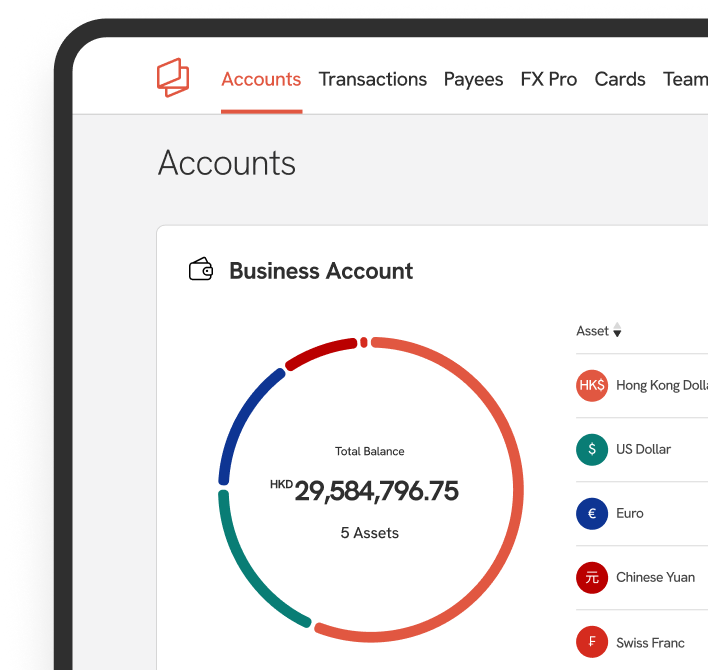Key Takeaways
A virtual IBAN is a standard numbering system used to identify a bank account in a cross-border money transaction.
Global businesses can benefit from having a virtual IBAN account as it simplifies and reduces the cost of international transfers and payment reconciliation.
Opening a virtual IBAN account is not complicated; most of the IBAN payment process can be automated.
A virtual IBAN account is a convenient way for businesses to make cross-border payments without spending too much time.
This type of international money transfer account facilitates companies that do business with clients outside their borders.
In a globalised world with various financial opportunities, businesses in expansion need a simple and efficient way to keep up with the demands of global commerce.
Opening a virtual IBAN account is a great way to serve these demands.
However, before you open a virtual IBAN account, it is important to have some background knowledge about the process and dynamics that shape IBAN accounts.
Continue reading for useful information about IBAN, virtual IBAN accounts, and how to open an IBAN account online.
What Does IBAN Stand For?
IBAN is short for International Bank Account Number.
It is a set of numbers that is used to make and receive international payments. It allows banks from overseas to identify your bank account.
The numbers that make up an IBAN aren't just randomly put together.
These IBAN numbers are comprised of up to 34 letters and numbers. They are specifically grouped to identify certain elements about the sender or receiver of the transaction.
An IBAN begins with a two-character code that identifies the account holder's country, then two check digits to avoid errors, and another 30 alphanumeric characters pointing to a bank account number.
The History of IBAN Accounts
The European Committee for Banking Standards initially implemented IBAN accounts.
Before 1997, there were numerous errors in the international money transfer system. Many cross-border transfers would not be finalised, and oftentimes, money would be sent to the wrong account or country.
After the ECBS adopted the IBAN system, the error rate dropped to .01 %.
The IBAN system is now a common standard for international money transfers, mainly in Europe and some countries in the Middle East and the Caribbean.
However, the system is not used in some countries, such as the United States, Canada, New Zealand, and Australia, where the SWIFT code is preferred.
As a result of globalisation and since the IBAN system has been facilitating European businesses to make international trade conveniently, the conventional IBAN system has been adapted to a virtual IBAN account.
Virtual IBAN vs. Regular IBAN
A Virtual IBAN and a regular IBAN both facilitate international bank transactions by providing a standardised account number format. However, they have distinct differences.
Nature and Functionality:
A Virtual IBAN doesn't represent a traditional bank account. Instead, it's a reference number that directs payments to a physical "collection account." In contrast, a regular IBAN is tied to a genuine bank account, capable of holding funds and offering standard banking services, typically associated with a specific bank branch.
Purpose and Usage:
Virtual IBANs are designed to segregate and streamline incoming payments. Businesses often assign different virtual IBANs to various customers or departments, making payment reconciliation more straightforward. A regular IBAN, however, is versatile, catering to a wide range of banking activities from sending to receiving payments and other standard banking functions.
Flexibility:
Virtual IBANs shine in terms of flexibility. A business can link multiple virtual IBANs to one physical account, optimising payment segregation and reconciliation. With regular IBANs, each number usually corresponds to a separate physical bank account, potentially leading to more administrative overhead.
Duration: Virtual IBANs can be temporarily tailored for specific customers or transaction types. They can be deactivated once their role is complete without the need to close a real bank account. A regular IBAN's lifespan is directly tied to the longevity of its associated physical bank account.
Cost Implications: For businesses handling numerous international transactions, Virtual IBANs are often more cost-effective. They can minimise the necessity for multiple bank accounts across different countries. Regular IBANs, on the other hand, come with the typical costs of maintaining a bank account, such as monthly charges, transaction fees, and other related expenses.
While both Virtual and Regular IBANs facilitate international transactions, they serve different needs. A Virtual IBAN acts as a flexible payment routing tool, especially beneficial for businesses, whereas a regular IBAN offers the comprehensive services of a traditional bank account.
How to Open a Virtual IBAN Account
Here are the 4 steps on how to open a virtual IBAN account.
Step 1: Set Up a Collection Account:
Purpose: The collection account acts as the central hub for your virtual IBANs. It's where funds from all secondary or virtual IBANs are consolidated.
Action: Approach your preferred banking or financial institution that offers virtual IBAN services. Discuss your business needs and initiate the process to set up a collection account.
Step 2: List Your Customers:
Purpose: Keeping a clear record of which customers require virtual IBANs can streamline the setup process and ensure no one is missed.
Action: Review your business operations and identify customers or partners who will be transacting through these virtual IBANs. Create a comprehensive list, noting any specific requirements they might have.
Step 3: Submit Requests:
Purpose: Each virtual IBAN will be linked to a specific customer or transaction type. By submitting individual requests, you ensure that each IBAN is tailored to its intended use.
Action: Using the list from Step 2, submit individual requests to your provider for each virtual IBAN. Ensure you provide all necessary details, such as the customer's name, transaction type, and any other relevant information.
Step 4: Choose Your Payment Processing Method:
Purpose: Different payment processing methods cater to different business needs, from speed to international capabilities.
Action: Research the payment processing options offered by your provider. This might include instant transfers, batch processing, or SWIFT transfers. Consider factors like transaction speed, fees, and international capabilities. Once you've evaluated the options, select the method that best aligns with your company's operational requirements.
💡Did you know? You can open a business account with Statrys if you have a registered business in Hong Kong, Singapore, or the BVI.
How Do Virtual IBAN Accounts Work?
A virtual IBAN, or a virtual account, is a reference number used to send incoming payments to a physical bank account.
Suppose a business processes a large number of international payments. In that case, a virtual IBAN is a practical solution to the complicated process of traditional cross-border and multi-currency money transfers.
Here Is a Quick Scenario
Let's say you are a company owner in France, and your business has customers in different countries around the world, including the United Kingdom, Denmark, Sweden, Brazil, Qatar, and the UAE.
You would be receiving cross-border payments from these countries in multiple currencies on a regular basis.
Without a virtual IBAN, your clients in Qatar would need additional reference information to make successful payments to France, and customers in Sweden might be charged additional transaction fees for every payment. You might have to open bank accounts in all of those countries.
You would also have to invest extra time, money, and people to monitor incoming payments manually.
However, with a virtual IBAN account, you can create a unique number dedicated to each customer in multiple countries. These accounts would be linked to a master account, and every transaction would be rerouted to the main account of your business.
For example, your UK customers can pay to a local virtual IBAN, and that money would be redirected to your master IBAN, which is tied to your physical bank account in France.
You can also completely manage virtual IBAN online and easily identify incoming payments, which simplifies and streamlines the process of cross-border transactions for your business.
What Are the Benefits of Virtual IBANs?
- Reduce the cost: a virtual IBAN is less expensive than a normal bank account. Traditional banks typically charge a transaction fee for each international wire transfer. This cost is eliminated with a virtual IBAN.
- Efficient organisation: each customer can be assigned a unique virtual IBAN account, which makes the reconciliation process easier.
- Automated process: All deposits, transfers, and settlements using a virtual IBAN can be automated. This saves business owners a substantial amount of precious time.
- Multi-currency transfer: a virtual IBAN facilitates international businesses to transfer funds in multiple currencies and to multiple counties and jurisdictions.
- One master account: virtual IBAN accounts eliminate the need to set up multiple bank accounts in different regions and countries.
What to Watch Out For
One of the problems with international money transfers is when the information about the receiver's account is filled in incorrectly. This was a significant issue in Europe's traditional cross-border transfer system.
To avoid any inconvenience, you should always be careful with the IBAN.
Between many possible numbers and the vast range of country codes, it is easy to miss a part of an account number for a transaction, which could cause unnecessary delays in the payment or even cause you to lose money.
Use an IBAN calculator to ensure that you're not missing any digits. This is one way to ensure you have a correct IBAN.
💡Tip: Sometimes, an IBAN could be rejected because it contains a different country code than the country where the payment is attempted to be made. This is called IBAN discrimination, which is actually against the SEPA regulation.
FAQs
What is IBAN?
IBAN is short for International Bank Account Number. This bank account number is used to make and receive payments on a global scale.
What is the format of an IBAN number?
What is a virtual IBAN?



.png?ixlib=gatsbyFP&auto=compress%2Cformat&fit=max&rect=416%2C0%2C2048%2C2048&w=680&h=680)



